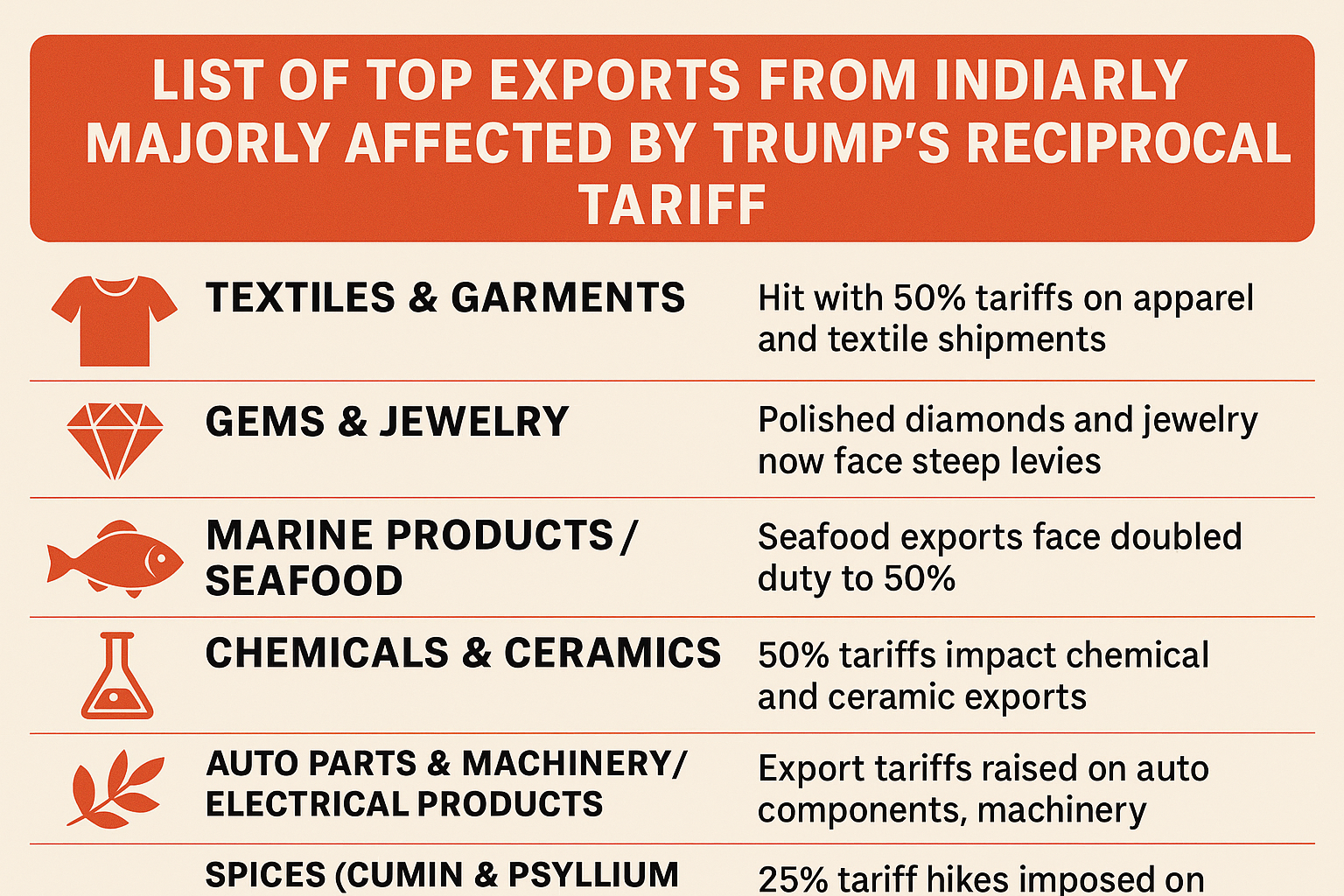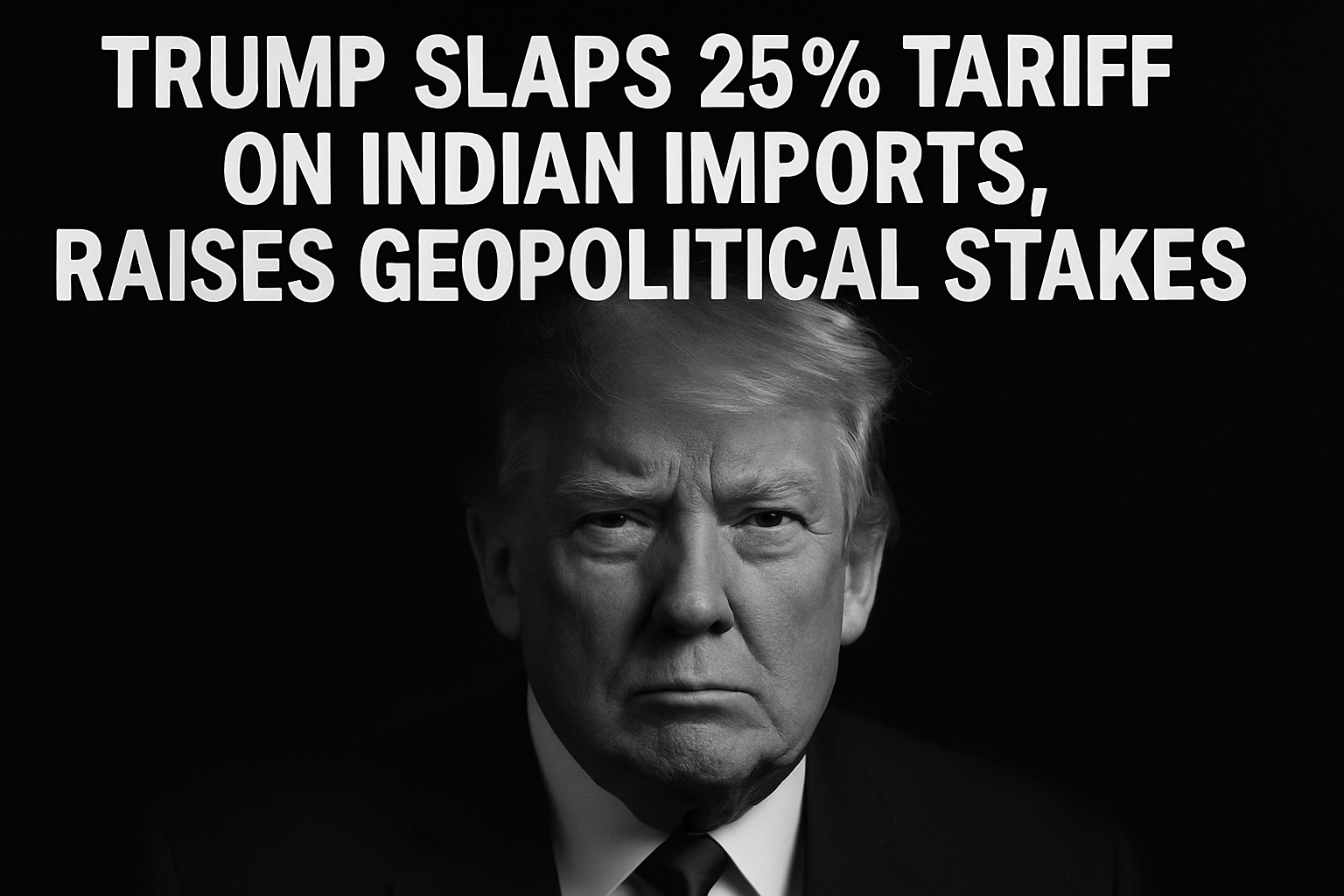India–U.S. trade relations have taken a sharp turn in 2025 with the reintroduction of tariffs under President Donald Trump's administration. A new executive order has imposed an additional 25% reciprocal tariff on Indian-origin goods, citing geopolitical reasons notably India’s continued purchase of discounted Russian oil. Combined with existing duties, many Indian exports now face total tariffs of up to 50%, significantly impacting key sectors and exporters.
This article presents a comprehensive breakdown of top Indian exports to the U.S. that are currently facing the brunt of these tariff hikes.
What Are Reciprocal Tariffs and Why Are They Imposed?
Reciprocal tariffs are trade duties imposed by one country to match or counter the tariffs already in place by another. In this case, the U.S. under Trump’s second term has cited “trade imbalances and strategic non-alignment” as justification to impose retaliatory tariffs on a wide range of Indian goods.
Effective August 1, 2025, an initial 25% tariff was imposed. On August 6, a second executive order added another 25% penalty on the same goods, which will take effect from August 27, 2025. The result: tariffs up to 50% on hundreds of products exported from India to the U.S.
Top Indian Exports Now Facing High U.S. Tariffs
Below is a list of key export product categories from India that are now facing up to 50% tariff, drastically reducing competitiveness in the American market:
| **HS Code** | **Export Category** | **Export Value (Approx.)** | **New U.S. Tariff** |
|---|---|---|---|
| 71 | Gems & Jewelry (Diamonds, Gold) | ~$10.2B | ~49–50% |
| 85 | Electronics (non-Apple phones, LED panels) | ~$9.9B | ~40–50% |
| 30 | Pharmaceuticals (non-exempt generics) | ~$8.0B | 0–25% (partial) |
| 27 | Refined Petroleum Products | ~$7.0B | ~30%+ |
| 84 | Industrial Machinery, Boilers | ~$6.5B | ~30–45% |
| 29 | Organic Chemicals, Dyes, Agrochemicals | ~$2.6B | ~30–40% |
| 63 | Home Textiles, Cotton Fabrics | ~$2.5B | ~35–45% |
| 73 | Iron & Steel Articles | ~$2.8B | ~30–40% |
| 87 | Auto Components (Brake pads, filters) | ~$2.6B | ~45–50% |
| 61 / 62 | Apparel & Garments (Knit/Woven) | ~$5.0B (combined) | ~35–45% |
| 64 | Leather Footwear, Sandals | ~$1.8B | ~45–50% |
| 3 | Marine Products (Shrimp, Fish Fillets) | ~$3.0B | ~35–50% |
| 42 | Leather Bags, Wallets | ~$1.5B | ~45–50% |
| 95 | Toys, Games, Dolls | ~$0.6B | ~45–50% |
| 21 | Processed Food, Pickles, Ready Snacks | ~$0.5B | ~45–50% |
| 44 | Wooden Handicrafts, Panels | ~$0.3B | ~45–50% |
| 10 | Basmati Rice | ~$0.9B | ~25–30% |
| 09 | Spices (Cardamom, Pepper, Cumin) | ~$0.7B | ~25–30% |
Note: Some high-profile products like Apple iPhones and essential pharmaceuticals have been exempted from the additional 25% tariff at least for now.
Which Sectors Are Hurt the Most?
1. Jewelry and Diamonds
India’s gem and jewelry sector particularly polished diamonds is reeling. These products now face close to 50% import duty in the U.S., threatening exports worth over $10 billion annually.
2. Textile and Apparel
India’s garments and home textile exporters, primarily small-scale businesses, are witnessing order cancellations as effective tariff rates hit 35–45%, pushing buyers toward Vietnam and Bangladesh.
3. Marine Exports
Frozen shrimp and seafood products, a major export from Andhra Pradesh and Kerala, are now taxed up to 50%, risking ₹24,000 crore worth of annual trade.
4. Auto and Engineering
Indian-made brake pads, components, fans, motors, and engineering tools now face steep cost escalation, making them less competitive compared to East Asian alternatives.
Economic Impact at a Glance
- 55% of India’s total exports to the U.S. (~$86.5 billion) are now under high-tariff risk.
- Affects labor-intensive sectors: MSMEs, textile clusters (Tirupur, Ludhiana), diamond cutting hubs (Surat), and seafood hubs (Kochi, Vizag).
- Likely to disrupt long-term contracts and push U.S. importers toward non-tariffed alternatives.
What Can India Do?
India’s Ministry of Commerce and FIEO (Federation of Indian Export Organisations) are actively compiling product-level impact reports and pursuing bilateral talks. Policy analysts recommend:
- Fast-tracking FTAs with EU and UK to offset U.S. dependency
- Tariff relief requests for MSMEs
- Expanding value-added exports to new markets in Africa, ASEAN, and Latin America
Final Thoughts
President Trump’s 2025 tariff regime has introduced a major challenge for Indian exporters, particularly those operating in already-competitive sectors. While some exemptions exist, a majority of India’s export portfolio to the U.S. especially jewelry, garments, leather, seafood, and machinery now faces crippling tariffs approaching 50%.
If India is to maintain its global trade momentum, diversification and diplomatic trade solutions must now take center stage.



